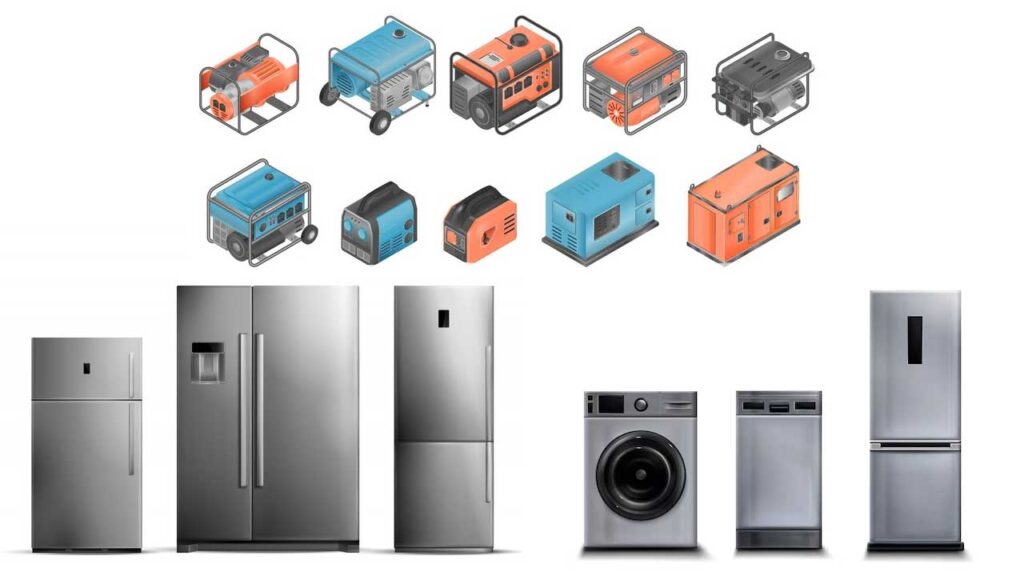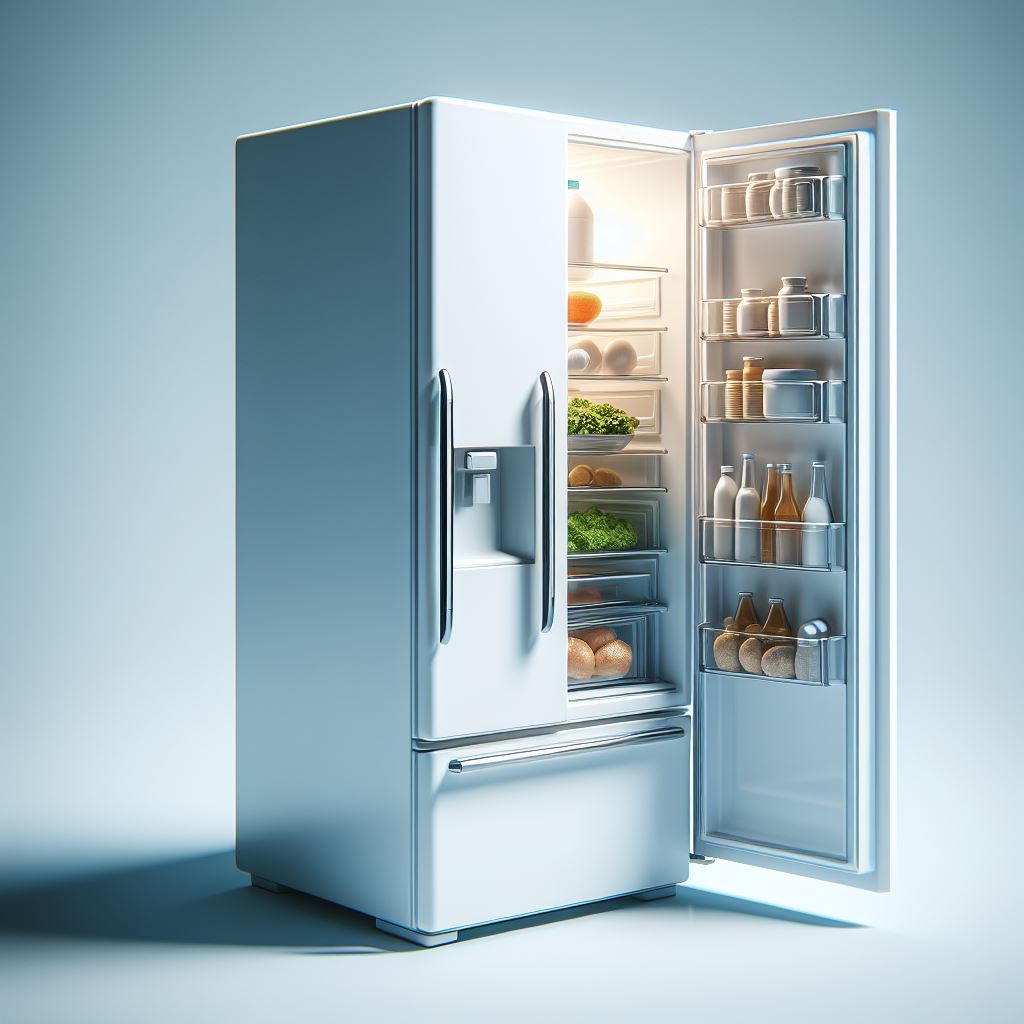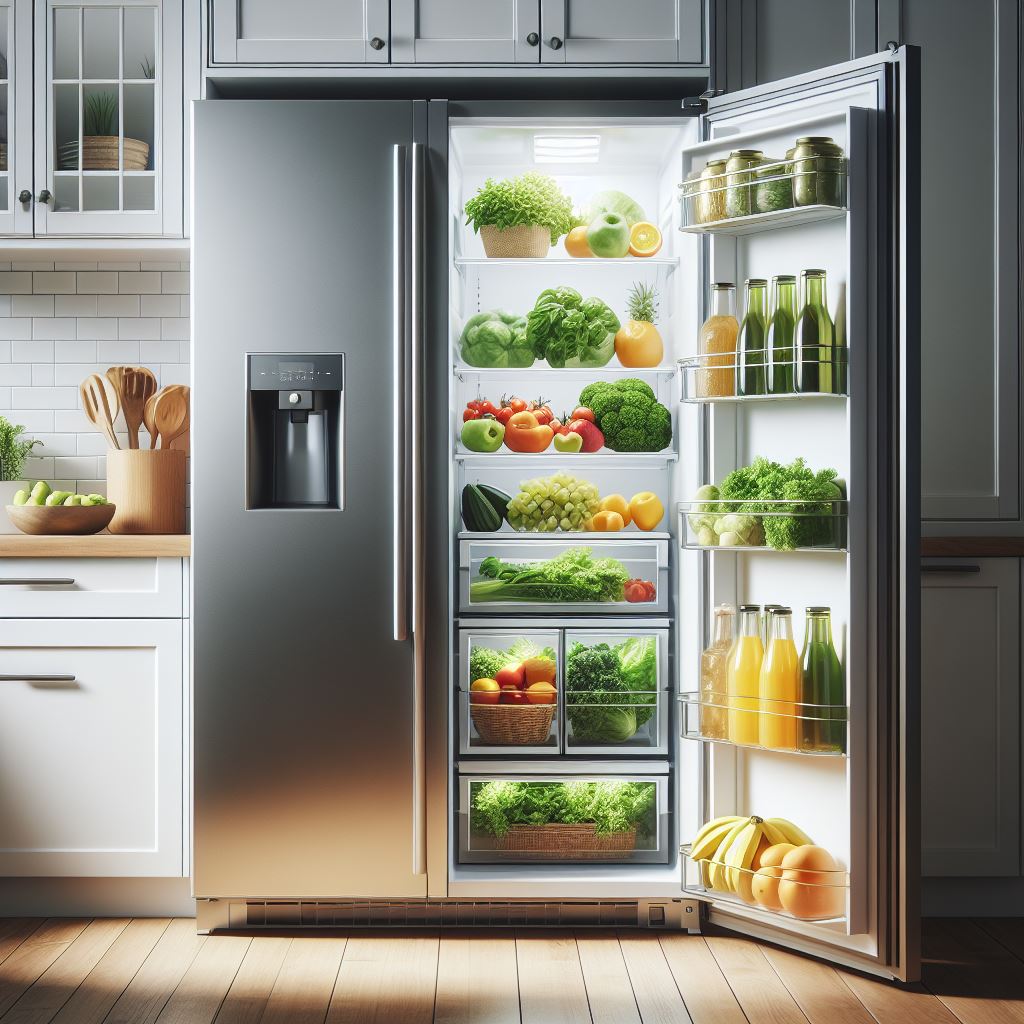A refrigerator is one of the most essential appliances in your home. It keeps your food fresh and safe, and it saves you money and time. But what happens when the power goes out? How can you keep your refrigerator running and prevent food spoilage? The answer is to use a generator.
A generator is a device that converts mechanical energy into electrical energy. It can provide backup power to your refrigerator and other appliances during a power outage. However, not all generators are created equal. You need to choose the right generator size for your refrigerator, depending on its power requirements and your budget.
In this article, I will show you how to choose the right generator size for your refrigerator. I will also explain how to use and maintain your generator safely and efficiently. By following these tips, you can keep your refrigerator running smoothly and protect your food from spoiling.
How to Determine Your Refrigerator’s Power Requirements?
The first step to choosing the right generator size for your refrigerator is to determine how much power your refrigerator needs. To do this, you need to find two key pieces of information: the running wattage and the starting wattage of your refrigerator.
The running wattage is the amount of electricity your refrigerator needs to keep running continuously. The starting wattage is the amount of electricity your refrigerator needs to start up or come out of idle mode. The starting wattage is usually 2-3 times higher than the running wattage, and it lasts for a few seconds.
You can find these numbers on the nameplate or technical specs label of your refrigerator, usually located inside the door or on the back of the unit. The nameplate will show you the voltage (V) and the current (A) of your refrigerator. To calculate the wattage (W), you need to multiply them:
W = V x A
For example, if your refrigerator has a voltage of 120V and a current of 5A, then its running wattage is:
120V x 5A = 600W
To calculate its starting wattage, you need to multiply its running wattage by 2 or 3:
600W x 2 = 1200W
600W x 3 = 1800W
Therefore, its starting wattage is between 1200W and 1800W.
As a general guideline, here are the typical power requirements for different sizes of refrigerators:
- Small fridge (up to 10 cubic ft): Runs on 300-500W, requires 500-1000W starting wattage
- Medium fridge (10-20 cubic ft): Runs on 500-700W, requires 1000-1500W starting wattage
- Large double-door (20+ cubic ft): Runs on 700-900W, requires 1500-2500W starting wattage
Of course, these numbers may vary depending on the model and brand of your refrigerator, so it’s always best to check the nameplate or manual for accurate information.
How to Choose the Right Generator Size for Your Refrigerator?
Now that you know how much power your refrigerator needs, you can choose a generator that can provide enough power for it. However, there are some factors you need to consider before buying a generator:
Power output:
The power output of a generator is measured in watts (W) or kilowatts (kW). It indicates how much electricity the generator can produce at any given time. The power output of a generator is usually expressed in two values: rated watts and surge watts. Rated watts are the maximum power the generator can produce continuously. Surge watts are the maximum power the generator can produce for a short period of time, usually when starting up an appliance.
You need to choose a generator with a rated wattage that is higher than your refrigerator’s running wattage, and a surge wattage that is higher than your refrigerator’s starting wattage. For example, if your refrigerator runs on 600W and requires 1800W starting wattage, you need a generator with at least 600W rated wattage and 1800W surge wattage.
Run time:
The run time of a generator is how long it can run on a full tank of fuel. It depends on the fuel type, fuel capacity, power output, and load demand of the generator. The run time of a generator is usually expressed in hours or minutes per gallon or liter of fuel.
You need to choose a generator with a run time that is long enough to cover your expected duration of power outage. For example, if you expect to have a power outage for 8 hours, you need a generator with at least 8 hours run time per tank of fuel.
Running additional appliances simultaneously:
If you want to run other appliances besides your refrigerator using the same generator, you need to add up their power requirements and choose a generator with a higher power output. For example, if you want to run a refrigerator, a microwave, and a TV using the same generator, you need to add up their running wattage and starting wattage, and choose a generator with a rated wattage and surge wattage that are higher than the total.
However, you should avoid overloading your generator, as it can damage your appliances and the generator itself. You should also use extension cords that are compatible with your generator and appliances, and follow the safety precautions of the manufacturer.
Compatibility:
Not all generators are compatible with all refrigerators. Some refrigerators may have special features or requirements that need a specific type of generator. For example, some refrigerators may have electronic controls or sensors that need a stable and clean power supply. In this case, you need to choose an inverter generator, which produces electricity that is similar to the grid power. An inverter generator is also quieter, more fuel-efficient, and more eco-friendly than a conventional generator.
However, an inverter generator is also more expensive and has a lower power output than a conventional generator. You should check the compatibility of your refrigerator and generator before buying them.
To help you choose the right generator size for your refrigerator, here are some examples of generators that can run different sizes of refrigerators:
Small fridge (up to 10 cubic ft):
A 2000W inverter generator, such as the Yamaha EF2000iSv2, WEN 56200i, or Generac GP2200i, can run a small fridge safely and efficiently. These generators have a rated wattage of 1600W and a surge wattage of 2000W, which are enough to cover the running wattage and starting wattage of most small fridges.
They also have a run time of 10-12 hours per gallon of fuel, which is sufficient for most power outages. They are also lightweight, portable, quiet, and easy to use.
Medium fridge (10-20 cubic ft):
A 3000W inverter generator, such as the Honda EU3000iS, Champion 100263, or Westinghouse iGen4500, can run a medium fridge comfortably and reliably. These generators have a rated wattage of 2800W and a surge wattage of 3000W, which are enough to cover the running wattage and starting wattage of most medium fridges.
They also have a run time of 7-20 hours per gallon of fuel, depending on the load demand. They are also relatively quiet, fuel-efficient, and user-friendly.
Large double-door (20+ cubic ft):
A 5000W conventional generator, such as the DuroMax XP5500EH, WEN DF475T, or Generac GP6500E, can run a large double-door fridge powerfully and stably. These generators have a rated wattage of 4500W and a surge wattage of 5000W or more, which are enough to cover the running wattage and starting wattage of most large double-door fridges.
They also have a run time of 7-12 hours per tank of fuel, depending on the load demand. They are also durable, versatile, and easy to start.
How to Use Your Generator Safely and Efficiently?
Choosing the right generator size for your refrigerator is not enough to keep it running smoothly and efficiently. You also need to use your generator safely and efficiently.
A generator is a powerful device that can pose some risks if not used properly. It can cause electric shock, fire, carbon monoxide poisoning, or noise pollution. It can also damage your appliances or the generator itself if not connected or maintained correctly.
To use your generator safely and efficiently, follow these tips:
Read the manual:
Before using your generator, read the manual carefully and follow the instructions of the manufacturer. The manual will provide you with important information on how to operate, connect, maintain, and store your generator safely and efficiently.
Choose a suitable location:
Place your generator outside your home in a well-ventilated area away from windows, doors, vents, or flammable materials. This will prevent carbon monoxide from entering your home or causing fire hazards. You should also keep your generator dry and protected from rain or snow. You can use a canopy or a tarp to cover your generator but leave some space for air circulation.
Use proper cords and plugs:
Use heavy-duty extension cords that are compatible with your generator and appliances. The cords should be long enough to reach your appliances without stretching or tangling. The plugs should be three-pronged and grounded in reality and not prone to exaggeration. The plugs should also fit snugly into the outlets and not cause sparks or overheating.
Connect your appliances correctly:
Connect your refrigerator and other appliances to your generator one by one, starting with the most essential ones. Do not overload your generator or exceed its power output. You can use a power strip or a surge protector to distribute the power evenly and protect your appliances from voltage fluctuations. You should also turn off or unplug any appliances that you are not using to save fuel and reduce noise.
Maintain your generator regularly:
Check your generator’s oil level, air filter, spark plug, and fuel filter regularly and replace them if necessary. You should also drain the fuel tank and carburetor if you are not going to use your generator for a long time. This will prevent corrosion, clogging, or gumming of the fuel system. You should also clean your generator’s exterior and store it in a cool and dry place.
FAQ
Here are some frequently asked questions and answers about choosing the right generator size for your refrigerator:
What size generator do I need to run a refrigerator?
The size of the generator you need to run a refrigerator depends on the power requirements of your refrigerator. You need to find the running wattage and the starting wattage of your refrigerator, which are usually indicated on the nameplate or technical specs label of your refrigerator. The running wattage is the amount of electricity your refrigerator needs to keep running continuously. The starting wattage is the amount of electricity your refrigerator needs to start up or come out of idle mode. The starting wattage is usually 2-3 times higher than the running wattage, and it lasts for a few seconds.
You need to choose a generator with a rated wattage that is higher than your refrigerator’s running wattage, and a surge wattage that is higher than your refrigerator’s starting wattage. For example, if your refrigerator runs on 600W and requires 1800W starting wattage, you need a generator with at least 600W rated wattage and 1800W surge wattage.
As a general guideline, here are the typical power requirements for different sizes of refrigerators:
- Small fridge (up to 10 cubic ft): Runs on 300-500W, requires 500-1000W starting wattage
- Medium fridge (10-20 cubic ft): Runs on 500-700W, requires 1000-1500W starting wattage
- Large double-door (20+ cubic ft): Runs on 700-900W, requires 1500-2500W starting wattage
Of course, these numbers may vary depending on the model and brand of your refrigerator, so it’s always best to check the nameplate or manual for accurate information.
How can I find out the power output and run time of a generator?
The power output and run time of a generator are usually indicated on the product description or manual of the generator. The power output is measured in watts (W) or kilowatts (kW), and it indicates how much electricity the generator can produce at any given time. The power output of a generator is usually expressed in two values: rated watts and surge watts. Rated watts are the maximum power the generator can produce continuously. Surge watts are the maximum power the generator can produce for a short period of time, usually when starting up an appliance.
The run time of a generator is how long it can run on a full tank of fuel. It depends on the fuel type, fuel capacity, power output, and load demand of the generator. The run time of a generator is usually expressed in hours or minutes per gallon or liter of fuel.
You can also use online calculators or tools to estimate the power output and run time of a generator based on your specific needs and preferences. For example, you can use this [generator sizing calculator] to find out how much power you need for your appliances and how long you want your generator to run. You can also use this [generator comparison tool] to compare different models and brands of generators based on their features and specifications.
How can I use my generator safely and efficiently?
To use your generator safely and efficiently, you should follow these tips:
- Read the manual: Before using your generator, read the manual carefully and follow the instructions of the manufacturer. The manual will provide you with important information on how to operate, connect, maintain, and store your generator safely and efficiently.
- Choose a suitable location: Place your generator outside your home in a well-ventilated area away from windows, doors, vents, or flammable materials. This will prevent carbon monoxide from entering your home or causing fire hazards. You should also keep your generator dry and protected from rain or snow. You can use a canopy or a tarp to cover your generator but leave some space for air circulation.
- Use proper cords and plugs: Use heavy-duty extension cords that are compatible with your generator and appliances. The cords should be long enough to reach your appliances without stretching or tangling. The plugs should be three-pronged and grounded in reality and not prone to exaggeration. The plugs should also fit snugly into the outlets and not cause sparks or overheating.
- Connect your appliances correctly: Connect your refrigerator and other appliances to your generator one by one, starting with the most essential ones. Do not overload your generator or exceed its power output. You can use a power strip or a surge protector to distribute the power evenly and protect your appliances from voltage fluctuations. You should also turn off or unplug any appliances that you are not using to save fuel and reduce noise.
- Maintain your generator regularly: Check your generator’s oil level, air filter, spark plug, and fuel filter regularly and replace them if necessary. You should also drain the fuel tank and carburetor if you are not going to use your generator for a long time. This will prevent corrosion, clogging, or gumming of the fuel system. You should also clean your generator’s exterior and store it in a cool and dry place.
In this article, I have shown you how to choose the right generator size for your refrigerator. I have also explained how to use your generator safely and efficiently. By following these tips, you can keep your refrigerator running smoothly and protect your food from spoiling.
I hope you have found this article helpful and informative. If you have any questions or comments, please feel free to leave them below. Thank you for reading!







